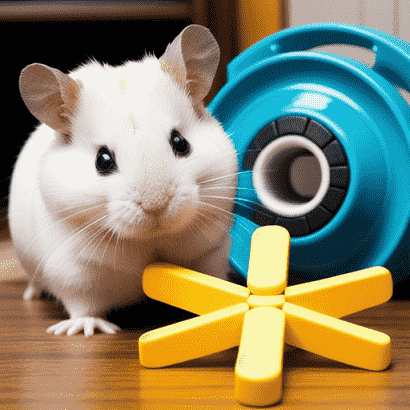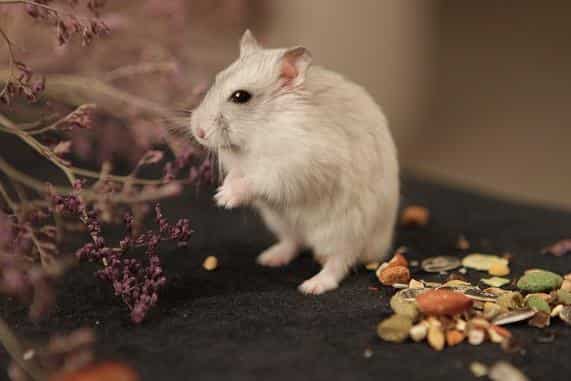Have you ever wondered when your tiny furball will hit ‘hamster adulthood’?
Well, your inquisitive journey ends here!
With years of experience in small pet care, I’ve got the answers to all your questions about hamster adulthood.
We’ve organized this guide clearly and concisely to ensure that this adventure isn’t a maze like a hamster’s cage! 🙂
From the different growth stages of hamsters to tips to enhance your hamster’s lifespan, we’ve got you covered!
Let’s dive in!
Table of Contents
Growth Stages of Hamsters
Embarking on our exploration, the first stop is understanding the various growth stages of a hamster. It’s a process as fascinating as the critters themselves. A hamster’s life can be roughly divided into four key stages:
Newborn to Weaning Stage
Newborn hamsters, also known as pups, are born hairless, blind, and completely dependent on their mothers. Around 10-14 days after birth, their eyes open, and they begin to explore their surroundings.
At about three weeks of age, they are weaned from their mother and start consuming solid food.
Juvenile Stage
This stage, starting from the end of weaning until about five weeks, is marked by rapid growth and development. Juvenile hamsters are full of energy and curiosity as they begin to explore their world in earnest. They learn to eat, play, and socialize during this period.
Adolescent Stage
During the adolescent stage, from approximately 5-8 weeks, hamsters reach sexual maturity. This phase is characterized by active growth and an increasing interest in social interactions, particularly in dwarf hamsters. Syrian hamsters, on the other hand, start displaying solitary tendencies.
Young Adult Stage
From 8-10 weeks, hamsters enter the young adult stage, where they’re fully grown but haven’t reached the complete maturity associated with hamster adulthood. During this time, they fine-tune their social, exploratory, and foraging skills.
Reaching Adulthood: When Do Hamsters Reach Maturity?
The transition from cuddly youngster to mature adult in hamsters is quite a fascinating journey. But how old is a hamster when it reaches adulthood? Let’s delve into that!
- Generally, a hamster reaches maturity or adulthood around 8-10 weeks of age. This is when they are fully grown and capable of reproducing.
- However, like humans, the maturity timeline varies slightly between different hamster species.
- Dwarf hamsters, for example, tend to reach adulthood a bit earlier, usually around 6-7 weeks of age. These little furballs are known to mature fast!
- On the other hand, the Syrian hamsters, one of the largest species, take their time, typically becoming adults between 8-12 weeks.
So, while each hamster’s journey to adulthood may vary slightly, you can generally expect your furry friend to enter the adult stage somewhere between 6-12 weeks.
This phase marks the onset of their full-fledged life – a life filled with exploration, adventure, and countless moments of joy.
Enhancing Your Hamster’s Lifespan: Tips for a Long and Healthy Life
There are certain milestones that you, as a pet parent, can help your little furball achieve. One such significant goal is ensuring a long, healthy, and fulfilled life.
Let’s dive into some vital areas to focus on.
Providing a Balanced and Nutritious Diet
Like us, our hamster friends need a balanced, nutritious diet for overall health. A variety of grains, fruits, veggies, and proteins, as well as hamster pellets, will do the trick. Hydration is just as important, so always provide fresh water.
Creating a Suitable Habitat and Environment
A suitable environment does wonders for a hamster’s lifespan. Spacious, well-ventilated cages with plenty of hideouts and toys offer your hamster the space to play, rest, and exercise.
Let’s remember the comfortable bedding for their burrowing instincts!
Regular Veterinary Check-ups and Preventive Care

Routine vet visits help spot any health issues early, allowing for effective preventive care. Yearly check-ups are a good rule of thumb. These visits will ensure your hamster stays in top form through its adulthood.
Maintaining Proper Hygiene and Cleanliness
Keeping your hamster’s living space clean is paramount to preventing diseases. Regular cleaning of the cage, food bowls, water bottles, and toys will keep harmful bacteria at bay, ensuring a healthy environment for your furball.
Ensuring Adequate Exercise and Mental Stimulation

Exercise wheels, tunnels, and hamster balls provide the necessary physical activity and mental stimulation. They can contribute to your pet’s overall well-being and prolong their lifespan.
Handling and Bonding with Care and Gentleness
A gentle approach when handling your hamster builds trust and reduces stress. Frequent, calm interactions foster a strong bond and make your hamster feel safe and loved.
Minimizing Stress and Providing a Calm Environment
Reducing stressors like loud noises and sudden changes can help your hamster stay calm and relaxed. A tranquil environment plays a key role in your hamster’s overall well-being and longevity.
Monitoring for Signs of Illness or Health Issues
Monitoring your hamster for signs of illness or health issues is vital to their well-being. Keep an eye out for:
- Changes in appetite or water consumption.
- Abnormal behavior such as lethargy or aggression.
- Unusual physical changes like weight loss or gain, dull coat, or discharge from eyes or nose.
- Altered sleeping patterns or reduced activity levels.
- Difficulty in breathing, limping, or unusual droppings.
Recognizing these signs early can be key to effective treatment and a quick recovery, ensuring your furry companion stays in good health throughout adulthood.
Promoting a Safe and Enriching Lifestyle
Safety is essential for a long hamster life. Prevent escape attempts by securing the cage. Provide an enriching environment with toys, chews, and activities that mimic their natural behaviors.
Building a Strong and Trusting Relationship with Your Hamster
Trust is the bedrock of your relationship with your hamster. Building a strong and trusting relationship with your hamster starts with gentle handling and consistent interaction.
Respect their space, provide a comfortable environment, and be patient. Regular, calm interactions will make your hamster feel secure and loved, strengthening the bond between you two.
Understanding Hamster Behavior during Adulthood
Cracking the code of your hamster’s behavior can be a bit like solving a furry, fast-paced puzzle. It’s a vital part of the road to hamster adulthood and building a harmonious relationship with your little friend.
Let’s dive into the world of hamster mannerisms!
Social Behavior and Interaction
In the realm of social behavior, hamsters are a mixed bag. Syrian hamsters prefer solitude, while Dwarf hamsters often enjoy a companion. Understanding your hamster’s social needs is key to a happy, stress-free life.
Exploratory Behavior
Hamsters are born explorers! This behavior is often seen when they’re active, usually during dusk and dawn. They love to dig, burrow, and explore their surroundings, often using their strong sense of smell and touch.
Sleeping Patterns
Hamsters are primarily nocturnal or crepuscular, meaning they’re most active during the night or twilight hours. During the day, they prefer to catch up on their beauty sleep. Disrupting this pattern could lead to stress, so it’s best to let sleeping hamsters lie.
Communication and Body Language
Hamsters may not speak our language, but they have a rich language of their own. For instance, a hamster standing on its hind legs might be curious or alert.
Purring often indicates contentment, while hissing or squealing could be signs of distress. Keeping a keen eye on these signs will help you understand your furry pal better.
Conclusion
Navigating the road to “hamster adulthood” can be quite a journey, but with the right knowledge and care, it can be a wonderful experience. From understanding their growth stages to comprehending their behavior, you now have a blueprint to help your furry friend lead a long, happy life.
And remember, every hamster is unique, so enjoy each moment of this journey and cherish the bond you build with your little furball. After all, the little things make this journey truly unforgettable.
FAQs
At what age is a hamster fully grown?
Hamsters are generally considered fully grown and reach their adult size between 6-12 weeks, depending on the species.
What are some signs of a hamster reaching adulthood?
Signs of a hamster reaching adulthood include a halt in physical growth, development of adult fur, increased activity and exploration, and the ability to reproduce in the case of females.
How can I ensure my hamster lives a long and healthy life?
A balanced diet, a suitable living environment, regular exercise, and scheduling routine vet check-ups are key to ensuring your hamster enjoys a long and healthy life.
Alina Hartley is a small-town girl with a ginormous love of bearded dragons. It all started with Winchester, a baby bearded who was abandoned at the shelter by his former owners because of a birth defect that caused one front leg to be shorter than the other. Alina originally went to the shelter looking for a guinea pig, but one look at Winchester and it was love at first sight. From that day on, Alina has dedicated her life to learning everything she can about bearded dragons. She loves helping new beardie parents start their incredible journey with these magnificent reptiles.
Follow her on:
LINKEDIN
TWITTER.
Read her latest articles HERE
Learn more about her HERE.

